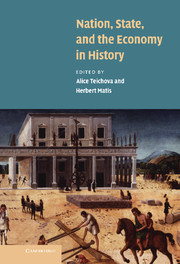Book contents
- Frontmatter
- Contents
- List of figures
- List of tables
- List of contributors
- Acknowledgements
- Introduction
- PART I
- 1 Political structures and grand strategies for the growth of the British economy, 1688–1815
- 2 Economic factors and the building of the French nation-state
- 3 Nation building in Germany: the economic dimension
- 4 The harmony liberal era, 1845–1880: the case of Norway and Sweden
- 5 Nationalism in the epoch of organised capitalism – Norway and Sweden choosing different paths
- 6 Economic development and the problems of national state formation: the case of Spain
- PART II
- PART III
- PART IV
- PART V
- Index
- References
4 - The harmony liberal era, 1845–1880: the case of Norway and Sweden
Published online by Cambridge University Press: 07 September 2009
- Frontmatter
- Contents
- List of figures
- List of tables
- List of contributors
- Acknowledgements
- Introduction
- PART I
- 1 Political structures and grand strategies for the growth of the British economy, 1688–1815
- 2 Economic factors and the building of the French nation-state
- 3 Nation building in Germany: the economic dimension
- 4 The harmony liberal era, 1845–1880: the case of Norway and Sweden
- 5 Nationalism in the epoch of organised capitalism – Norway and Sweden choosing different paths
- 6 Economic development and the problems of national state formation: the case of Spain
- PART II
- PART III
- PART IV
- PART V
- Index
- References
Summary
INTRODUCING THE THEME
E. J. Hobsbawm has designated the years 1848–75 as ‘The Age of Capital’; they might as well be characterised as ‘The Harmony Liberal Era’. Not least so in Scandinavia, where the capitalistic breakthrough was accomplished with a minimum of those internal class struggles and internal–external national struggles that accompanied the general European development.
This relatively smooth outcome depended in the final analysis on circumstances that gave nationalism and economic liberalism – the two dynamic ideologies en vogue at the time – a less militant and problematic appearance in Scandinavia than elsewhere. As for nationalism, both Norway and Sweden could boast of an ancient domestic culture united by a common enough language spoken by a homogeneous population with few and small ethnic minorities (Lapps, Finns and Gypsies). A dogmatic view of economic liberalism (the ‘Manchester’ or ‘classical’ variant) was immediately confronted with hard Scandinavian facts that made atomistic individual freedom on the market seem unrealistic, at any rate in the short run. Norway and Sweden were both poor, sparsely populated and vast countries, circumstances which – from a nationalistic view – called for co-operation and for active intervention or guidance from the comparatively resourceful national state. The result was – to borrow Professor Rune Slagstad's pregnant wording – ‘a liberalism chastened by the State’, busy in ‘staging capitalism’.
Economic growth resulting in national prosperity played a key role in the political programme of the Scandinavian harmony liberals.
- Type
- Chapter
- Information
- Nation, State and the Economy in History , pp. 80 - 95Publisher: Cambridge University PressPrint publication year: 2003
References
- 1
- Cited by



